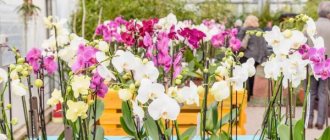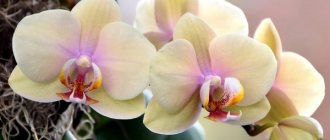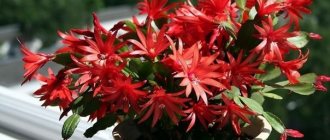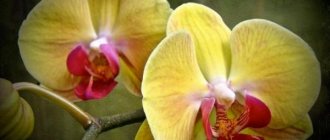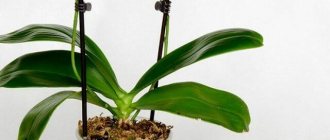When does flowering occur at home?
Different varieties of orchids begin to bloom at different ages . Usually the first buds appear when the flower is 1.5-3 years old. You can find out the age of an orchid by its shoots: if the plant is 2 years old or more, then there should be at least 5-8 of them.
Attention : Botany knows more than 30 thousand natural varieties of flowering orchids and the same number of artificially bred species of this plant.
After the orchid has bloomed and its peduncle has dried, you can wait for the next flowering no earlier than in 2-3 months. This fact is due to the fact that a healthy plant, with proper care, can generate flower stalks only 2-3 times a year , and the duration of flowering itself is usually about 3 months. However, not all orchids obey the general rules, and the reason for this is often the incorrect conditions of their maintenance and the owners’ ignorance of how to act correctly to achieve flowering.
Orchid blossom
If you ensure proper watering of the orchid for flowering, the result will not take long to arrive. However, novice flower growers often make a number of mistakes, after which the buds do not appear for a long time. It is important not only to correct the mistakes made in a timely manner, but also to prevent them from happening in the future.
Reasons for absence
The most popular reason is excessive moisture, resulting in:
- the root system begins to rot;
- Fungal diseases appear, after which the plant dies.
If you slightly dry the roots between waterings, you can thereby provoke the bush to bloom.
Why does it take so long for it to start?
There may be several reasons why an orchid is in no hurry to please its owner with flowers for more than a year, or even two.
Any type of orchid plant does not like moving in space. Even a pot turned the other side towards the light source becomes serious stress for them. As a result of rotating and rearranging the plant from place to place, delays in the appearance of the peduncle may occur, and the buds that have already formed may begin to fall off.- A common reason for an orchid not blooming may be that its root system is not getting enough light. It is the roots that ensure complete photosynthesis of the entire plant, so flowering orchids should be planted only in transparent pots.
- An orchid will never bloom if it doesn't have enough light. Therefore, for this plant to bloom, it is important to provide it with the proper level of light. On winter days, LED lamps will come to the rescue, helping to extend daylight hours for the required amount of time (as a rule, orchids require 10 hours of bright light for regular flowering).
- The absence of daily and seasonal temperature changes in the room also leads to a delay in the flowering of orchids. All that is needed in this case for flowering is to create conditions as close as possible to natural conditions for the plant, making sure that the air temperature at night is 4-6°C lower than during the day. An excellent solution would be to create an artificial winter for your green darling for at least 20 days at a temperature of 5-10°C above zero.
How to order flowers for delivery?
Stimulation of orchid flowering. How to make a beauty bloom Everyone who buys an orchid always brings it into the house already blooming and beautiful. But it often happens that at the end of flowering , you cannot wait long enough for your orchid to throw out its peduncle and again please you with the beauty of its flowering .
But you really want to admire the truly royal orchid bloom . So how do you stimulate an orchid to make it bloom ? We will study this very issue today.
A blooming orchid is the standard of beauty. Only a healthy and well-groomed plant is able to form flower stalks and set buds.
Reasons for lack of flowering
Lack of flowering is always a consequence that has its own explainable cause. An orchid is a plant that blooms at least 2 times a year, and if you have not seen flowers for more than a year, then you should understand the reasons for this phenomenon and eliminate them.
Violation of rest mode. One of the most common reasons why an orchid does not bloom is improper dormancy. Many people simply do not know how to provide the orchid with proper rest. We'll talk about how to organize it later.
Violation of the watering regime. Improper watering also negatively affects orchids. It is better to underfill them than to overfill them. Orchids that are watered abundantly very often may not produce fruit for the grower. They do not tolerate waterlogging. In places where they grow in nature, orchids never bloom during the rainy season because there is too much moisture.
Violation of lighting conditions. Lighting plays a very important role in the flowering of an orchid. Its deficiency or excess will lead to the fact that your picky woman will refuse to please you. She will help you control the light herself if you give her the necessary attention. It is enough to look carefully at the color of the leaves to determine. If the color is normal, then the leaves are green without pallor or darkness. If there is not enough light, they become dark green, but if there is too much light, the foliage will turn yellow.
Unhealthy roots. Roots are the basis of the plant and, of course, problems with the root system can lead to no flowering. When it has been gone for a year, it is worth examining the root system of your flower. With frequent watering, the roots very often begin to rot; even a small sign of rot will lead to the fact that the orchid will not bloom.
Rest period
The dormant period for an orchid is very important for subsequent flowering; if it is not provided, then you may not see any more flowering.
When does the rest period begin? This question interests all novice gardeners. As soon as the orchid has faded and its peduncle has completely dried out, the orchid enters a dormant period. This is a kind of vacation for the orchid on which it simply needs to be sent.
In order for the orchid to rest, it must be transported to a lower temperature. Choose the coolest room in your home, the ideal temperature for relaxation is no more than +18°C.
The light should be the same as for a blooming orchid, it should be enough.
Watering during the dormant period is reduced to a minimum; it should be carried out only when the substrate is already completely dry. Watering twice a month will be quite enough, and if the temperature is above ideal, then once every three weeks will be quite enough.
Seven ways to stimulate orchid blooms
When the orchid itself does not want to bloom, the owners have to help it and organize stimulation of flowering. There are several proven ways to stimulate an orchid to bloom, and we will, of course, consider them all.
Stress is a flowering stimulator
Stressing an orchid is an age-old way to force it to bloom. To do this, you need to send the orchid to a completely unusual place for it. A place under the bathroom is perfect. The ideal stress for an orchid is coolness, high humidity and lack of lighting. It must be sent to the link within 2 weeks. After this, place the orchid in its usual place.
Transparent orchid pot
The pot is very important for the flowering of the orchid; now there are a lot of them in stores. But it was and will always be the ideal pot for an orchid - a transparent pot, the same ordinary and nondescript, but very useful and ideal for an orchid. Because its roots really need light, the pot should always be transparent, even if you put it in a flower pot, it should also be transparent.
Additional illumination of the orchid
When an orchid's dormant period falls in the winter, it simply needs to be given additional lighting. An ordinary ice lamp is perfect; it needs to be turned on for 4-6 hours, depending on the length of daylight hours. If the sun sets already at 4 o'clock, then the light must be turned on for 6 o'clock. If there is little light, flowering may not begin until May.
Spending the night stimulates orchid flowering
If your orchid refuses to bloom at all, then you need to give it 2 weeks of tropical nights. Where it grows in the wild, night temperatures average +5°C. Therefore, the orchid will need to be sent to this temperature overnight. A corridor or basement is suitable as a night tropics, and if necessary, it can be placed in a refrigerator, if it can be created at this temperature.
Succinic acid – flowering stimulator
Succinic acid is a great helper for your orchid. It helps improve the health of your beauty. The use of succinic acid stimulates the orchid to release a peduncle, grow foliage and roots. For this purpose, you need to dissolve 1 tablet in 0.5 liters of water. It must be sprayed all over with this solution, and also watered with this solution. It is impossible to overdose with succinic acid, so you can constantly water, spray and wipe the foliage of your beauty with it.
Flowering and growth stimulator "Epin"
"Epin" is used to relieve stress in the plant. If there was a transplant or change of location, then it must be used for a non-blooming orchid. The foliage of the plant is sprayed with it; for watering it is never used exclusively by spraying.
Hot shower stimulates flowering
To stimulate flowering, use a hot shower once a week. Such a shower stimulates sap flow. You need to carry out the most ordinary watering, and after 30 minutes you need to buy the orchid under a hot shower, not just warm, but hot. The concept of a hot shower includes water at a temperature of +28...+35°C, but not higher than +35°C. Temperatures higher may burn the plant. Bathing is carried out for 40-60 seconds no longer. This shower can be done no more than once a week.
Orchid fertilizer for flowering
Until the orchid blooms, it needs to be fed. During this period, she simply needs additional nutrition so that she is as strong as possible and actively grows and gets stronger. It is best to use complex fertilizers that contain all the necessary vitamins and mineral fertilizers. If you use everything separately, it will be difficult for you to alternate and dose them. The advantage of the complex is that when diluted you will get the ideal concentration of all components that suits the plant.
When choosing a fertilizer, you need to get an opinion about it from those who have already used it and are using it. I and all my friends who are involved in breeding orchids settled on the “Master” fertilizer from. It is necessary to apply fertilizer only according to the instructions, not more often and without increasing the concentration. Overfeeding an orchid can also cause it to not bloom.
Fertilizer "Peters" for orchid blooms
"Peters" is the most popular fertilizer for orchids. It is sold in powder form and diluted in water according to the instructions. This fertilizer is aimed at rooting or flowering; there is also a form that combines both of these qualities.
“Peters Professional” is exactly the fertilizer that can be used for flowering orchids to enhance and prolong flowering, feed during the dormant period and stimulate flowering and the formation of new roots and leaves. This form of fertilizer is also used to reanimate plants that are sick. It is ideal for post-transplant recovery.
In general, this fertilizer is universal and you will not need to think about what period of your beauty’s life to use it so as not to harm it. For a beginning florist, Peters Professional is a real find.
Repeated flowering of orchid peduncle
When flowering has ended, this does not always mean that the orchid has completely faded and the peduncle needs to be removed. Do not do this under any circumstances. If the peduncle does not yet turn yellow, this means that it is not yet drying out and can bloom, but it needs help and stimulation.
“Cytokinin paste” will be an assistant in stimulating the flowering of the peduncle . This paste is nothing more than the hormone cytokinin, which is a powerful stimulator of flowering. However, remember that this paste can only be used on healthy plants. Plants that have suffered from diseases and weakened plants may not survive such powerful stimulation.
Cytokinin paste
In order to do this, carefully examine the peduncle, or rather the buds. If the scales on the bud are green and without dryness, then you can use these buds to stimulate the appearance of peduncle layering, which will produce flowering. Look at the scales in the photo:
Suitable kidney
Then take a thin needle, the most ordinary one you use for sewing. Dip it in alcohol to disinfect the needle and not harm the plant by infecting it.
Needle disinfection
Scratch the scale in the center and open it, revealing the bud as shown in the photo:
Opening an orchid bud with a needle
Then, using the same needle, apply the paste to the kidney, spreading it over the kidney. See the photo for how to do this. Then, after applying the paste, close the scale as in the photo:
Applying paste
That's all, wait for the bud to grow and your beauty to bloom again. Within a week you will receive layering.
Orchid care tips
When you carry out the necessary spraying, you must use a nozzle only with a fine spray. After spraying, be sure to check for water at the base of the leaves. If there is water in there, be sure to remove it from there by blotting it with a cotton pad, then wipe it with a cotton swab so that the base is dry.
When giving your orchid a hot shower, be sure to check the temperature and also remove water from the base of the leaves, otherwise they will begin to rot.
You shouldn’t change the place of the orchid often, it’s hard for it.
During the formation of buds, do not rearrange or move the pot of orchids, she will not like such anxiety, and she may partially discard them.
Never overfeed an orchid with fertilizers; it is better to have too little than too much; it is dangerous for their health. It is recommended to fertilize every second watering; you should not apply fertilizer every time.
When you stimulate an orchid to bloom and buy fertilizer for this, make sure that it contains potassium components. They are the ones who provoke flowering.
Excellent(0)Bad(0)
Is it necessary to artificially stimulate the plant?
In order for a recently transplanted orchid to produce large and bright flowers, care should be taken to artificially stimulate its flowering . It is important to make sure that the plant is completely healthy, has strong roots and powerful and fleshy leaves.
- Most often, an orchid's flowering is stimulated by placing it in a stressful situation. If the plant has begun to become “lazy” and has not put out a flower stalk for a long time, you can try to push it to flower by watering. To do this, immerse the pot in water heated to 40-45°C and leave it there for 30 minutes.
- A hot shower is also a useful stimulator for orchid flowering. Place the plant in the bath and pour a very warm stream of water over its leaves and roots (the temperature should be tolerable for your hands, otherwise you can burn the roots and leaves!).
- If the orchid has never bloomed yet, despite the appropriate age, as well as the number and quality of shoots, you can try sending it to a cool balcony for a week or two (the room temperature should not fall below 0°C). This procedure will simulate the wintering of the plant under natural conditions, thereby bringing its flowering period closer. After you bring the flower back into the house, a peduncle will soon appear on it.
Temperature
To keep phalaenopsis healthy, you need to maintain a certain temperature regime. But with one simple trick it is possible to cause it to bloom.
Give this exotic beauty a temperature difference. For example, take it out to the loggia at night. If the balcony is glazed, then place the container with the orchid closer to the open window. At the same time, make sure that the thermometer readings in this place are within 16 - 18 degrees.
Spring is best suited for such experiments. In the natural habitat of this crop, the difference between day and night temperatures is about 5 degrees. If it gets colder, the orchid will get sick. It is also not necessary to be warmer, otherwise this method will not work. During the day, place it in direct sunlight so that the leaves warm up.
The result will be the production of a sufficient amount of carbon dioxide, which will be enough for the development of roots and flower stalks.
Why doesn’t it produce buds and grow leaves?
Most often, a stop in development and growth is associated with a lack of fertilizers. To stimulate active vegetation, you should treat the leaves of the plant with a special fertilizer for phalaenopsis. After the vegetative function is completely restored, the plant will increase the necessary green mass and, subject to proper maintenance, will delight the owner with a young peduncle.
Read about how to understand why an orchid does not bloom here.
If it produces only roots and leaves
If the orchid does not bloom but produces leaves, it may be in a dormant period . As a rule, the resting time of orchid plants lasts from 1.5 to 3 months, during which the plant should be provided with a cooler temperature regime.
If there is no flowering for more than three months, it is necessary to understand the watering regime, as well as the humidity and temperature in the room where the orchid is kept. It is necessary to adjust the housing conditions and create stressful conditions for the plant to successfully force the peduncle.
We recommend watching a video about the reasons for the lack of flowering of an orchid when growing leaves:
How to make it produce buds by changing watering?
Watering regime is especially important for the successful flowering of an orchid . How to speed up flowering by changing watering? Water the plant by completely immersing the pot in water. In order for the dry substrate to be sufficiently saturated with moisture, it is necessary to remove the flowerpot from the decorative flowerpot and lower it into water for 3-5 minutes. After watering, the plant should be pulled out, excess water should be allowed to drain from the pot and put back in its original place.
Such manipulations should be performed once every two weeks in winter and once every 10 days in summer. More frequent bathing can lead to rotting of the root system and disease, and sometimes even complete death of the plant.
Orchids gravitate to the humid climate of the subtropics, so it is important to maintain high humidity in the room where they are grown. The plant should be sprayed daily using well-settled warm and soft water.
How to achieve flowering all year round?
The basis for success is constant optimal lighting. Under such conditions, any hybrid or natural orchid can bloom all year round. With good light, the plant immediately shoots out 1-2 or 3-4 flower stalks, old shoots lengthen. There must be a humidifier in the place where Phalaenopsis lives. Optimal air humidity is 70-80%.
How to water Phalaenopsis for long flowering?
Pay attention to the quality of irrigation water, use filtered or settled water. Fertilize several weeks before budding. Once every 2 weeks, take ice cubes and place them on the substrate.
Arrange weekly baths, immerse the pot in water at room temperature. Remove when the substrate is saturated with moisture, on average after 15-25 minutes. When excess water has drained, place it on a tray.
Additional measures:
- spraying with a growth stimulator - daily, in the morning. Add the composition to irrigation water;
- use a solution of succinic acid (1 g/1 l) - it stimulates long-lasting, abundant flowering. Irrigate the green mass, soak the roots;
- Use ready-made fertilizer "Epin" (5 drops/1 l) - anti-stress provokes a rapid growth of green mass and the formation of flower stalks. Spray in the morning;
- for urgent stimulation, take cytokine paste. The phytohormone will awaken sleeping buds. The orchid will produce strong flower stalks.
Important! Lack of flowering can be caused by intolerance to tobacco smoke, as well as if there are fruits near the flower that emit ethylene, which is harmful to it.
Is deep watering always necessary?
The plant body does not need constant abundant watering. If the roots receive small amounts of water periodically, there will be no flowers. Under natural growing conditions, the long rainy season is replaced by drought. First, the orchid requires abundant moisture saturation, then a sharp reduction in irrigation.
With a lack of moisture, the plant “understands” that it is time to produce a flower stalk. Make sure the soil remains dry for 4-7 days. Reduce moisture gradually while new shoots are growing. It is forbidden to create a drought at the end of the growing season with impaired leaf turgor and a depleted root system.
5 / 5 ( 1 voice )
How to stimulate by adjusting the length of daylight hours?
Tip : The reason for the orchid’s reluctance to bloom may lie in the lack of light. Care must be taken to ensure that the plant is illuminated for at least 10-12 hours a day. To ensure this condition, a phytolamp of a suitable spectrum that does not dry out the air is quite suitable.
Despite the light-loving nature of orchids, you should not place them on south-facing windows in the summer : there they can get sun and temperature burns. In addition, any plant needs a night rest phase for the photosynthesis process to properly occur, so do not forget the plant under the included phytolamp at night.

